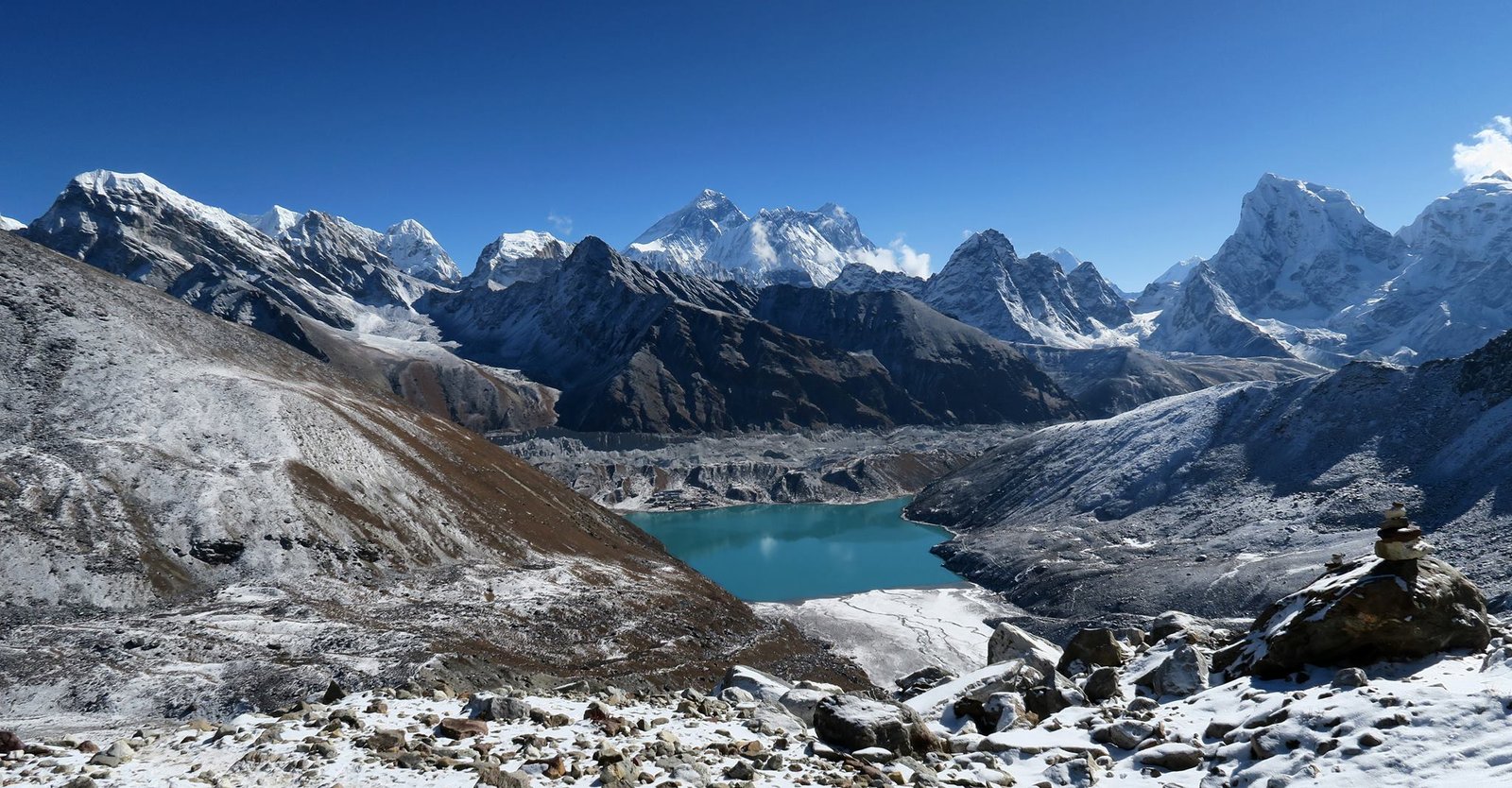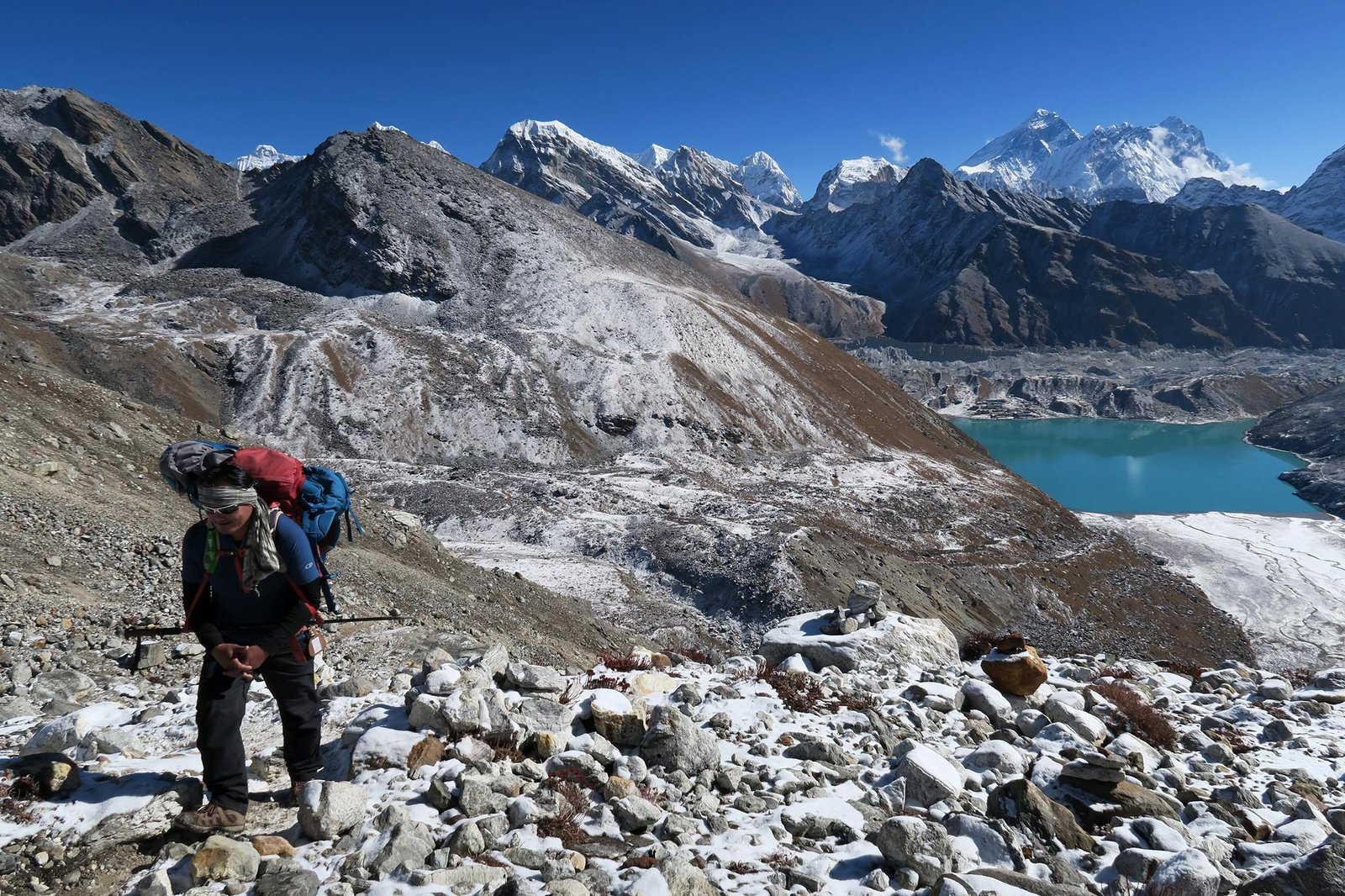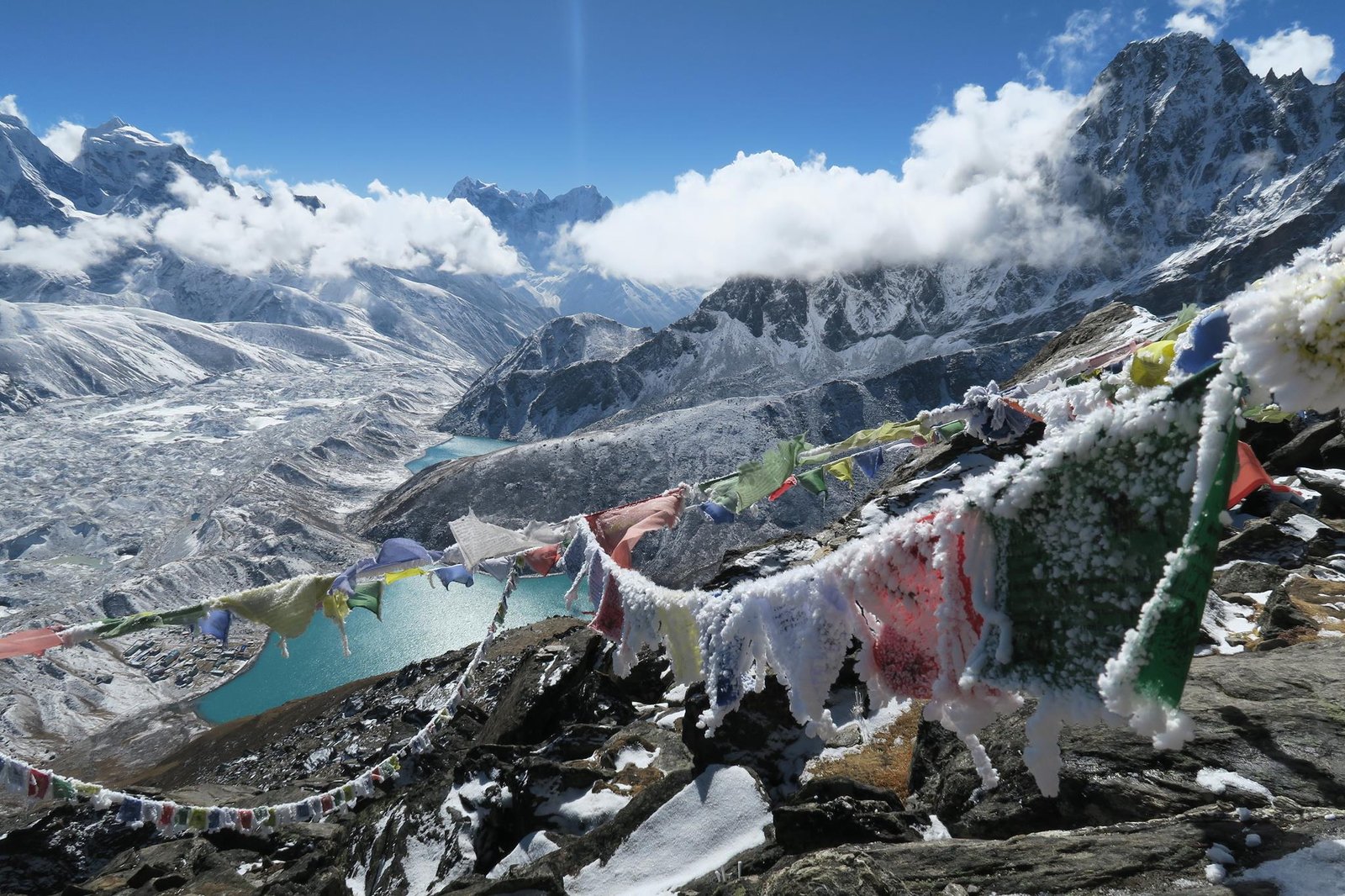Everest Base Camp Cho- La- Pass Gokyo Lake Trekking
fromEverest Base Camp Cho- La- Pass Gokyo Lake Trekking is one of the favorite routes of trekkers who love adventurous and challenging trekking in Nepal. Along with the EBC, you can also witness the beauty of the Cho La Pass, Gokyo Lake, and Gokyo Valley. Besides, Gokyo Lake – Cho La Pass and Everest Base Camp trek are some of the popular choices for trekkers. This trip leads trekkers into the marvelous Gokyo valley, sparkling and pristine blue and green water of the Gokyo Lakes. Also, Gokyo Lake is the homeland of alpine birds from around the world.
The Gokyo Lake System is a series of beautiful turquoise lakes in the Gokyo Valley. There are 19 lakes in total in the Gokyo Lake System. The popular Gokyo Lake is the third lake in the series. You can discover and explore the most awaited destinations of Khumbu Valley like Gokyo Lake, Chola Pass, and Everest base camp. Moreover, the trail leads us through the landmarks of the Khumbu region while at the same time experiencing the Himalayan Sherpa culture and traditions.
The majestically soaring mountains of the Himalayas, colorful ancient monasteries, Buddhist prayer flags, boulder-carved Tibetan Buddhist prayer inscriptions, Sagarmatha National Park, and Namche Bazaar are landmarks of this region. The trek also awards us with great views of Khumbu icefall. Trekking towards the Everest base camp via Gokyo Lake will be a lifetime experience. Similarly, Mt Everest, Mt Cho-Oyu, Mt Lhotse, Mt Makalu, Mt Nuptse, Mt Ama Dablam, and other mighty peaks are there to amaze you.
Highlights
- Kathmandu Valley Sightseeing on arrival and also before final departure.
- Scenic flight from Kathmandu to one of the world’s most dangerous airports, Lukla Airport
- Exploration of the Himalayan Sherpa culture and lifestyle
- Visiting the Gokyo Lake System and all the 19 lakes in that area.
- Major destinations: Gokyo Ri, Everest Base Camp, Kala Patthar, Khumbu Icefall
- Tour to Buddhist monasteries
-
Reviews 2 Reviews5/5
-
Vacation Style Holiday Type
-
Hunting
-
Jungle
-
-
Activity Level Challenging
-
Group Size Large Group
Overview of Everest Base Camp Gokyo Lake Trekking
Trekking to Everest Base Camp and Gokyo Lake is a popular and challenging adventure in the Everest region of Nepal. Both destinations offer stunning views of the Himalayas and unique cultural experiences. Here is a general itinerary for the combined Everest Base Camp and Gokyo Lake trek:
Gokyo Lake – Cho La Pass and Everest Base Camp trek are popular trek choices. This trip leads trekkers into the marvellous Gokyo valley, sparkling and pristine blue and green water of the Gokyo Lakes. Also, Gokyo Lake is the homeland of alpine birds worldwide.
The Gokyo Lake System is a series of beautiful turquoise lakes in the Gokyo Valley. There are 19 lakes in total in the Gokyo Lake System. The popular Gokyo Lake is the third lake in the series. You can discover and explore the most awaited destinations of Khumbu Valley like Gokyo Lake, Chola Pass, and Everest base camp. Moreover, the trail leads us through the landmarks of the Khumbu region while simultaneously experiencing the Himalayan Sherpa culture and traditions.
The majestically soaring mountains of the Himalayas, colourful ancient monasteries, Buddhist prayer flags, boulder-carved Tibetan Buddhist prayer inscriptions, Sagarmatha National Park, and Namche Bazaar are landmarks of this region. The trek also awards us with great views of Khumbu icefall. Trekking towards the Everest base camp via Gokyo Lake will be a lifetime experience. Similarly, Mt Everest, Mt Cho-Oyu, Mt Lhotse, Mt Makalu, Mt Nuptse, Mt Ama Dablam, and other mighty peaks are there to amaze you.
Outline Itinerary
Day 01: Kathmandu Arrival
Day 02: Kathmandu Valley Sightseen and trek preparation
Day 03: Flight from Kathmandu / Manthali Lukla (2850/9350ft) and Trek to Phakding 2650m/8562ft)
Day 04: Trek from Phadking to Namche Bazar (3440m/11286ft) approx. 6 hours trek
Day 05: Acclimatization and rest at Namche Bazar
Day 06: Trek from Namche Bazaar to Tengboche (3800m/12467ft) approx. 5 hours trek
Day 07: Trek from Tengboche to Dingboche (4,200 /13780ft) approx. 5-hour trek
Day 08: Acclimatization day in Dingboche.
Day 09: Trek from Dingboche to Lobuche (4,920 m/16142ft) approx. 5-hour trek
Day 10: Trek from Lobuche to Gorak Shep (5,164m/16942ft.) continues to Everest Base Camp (5,164m/16942ft) 8-hour trek)
Day 11: Hike to Kalapathar (5,545 m/18192ft) and Trek to Dzongla (4830m/15846) 7 – hours.
Day 12: Trek from Dzongla to Thangna (4700m/15420ft) via Cho La (5,420m/17,780ft) 8-9 hours.
Day 13: Trek from Thangna to Gokyo Lake (4490m/14730ft) approx. 4 Hour trek
Day 14: Climb to Gokyo RI (5357 m/17575ft) and Back to Dole (4110 m/13484ft) 6-hour
Day 15: Trek from Dole to Namche Bazaar (3440 m/11286ft) 5-hour
Day 16: Trek from Namche Bazaar to Lukla (2,860 m/9383ft., 6-hours)
Day 17: Lukla to Kathmandu by flight
Day 18: Free day in case of flight cancellation from Lukla
Day 19: Final Departure
This is Photoshop’s version of Lorem Ipsum. Proin gravida nibh vel velit auctor aliquet. Aenean sollicitudin, lorem quis bibendum auctor, nisi elit consequat ipsum, nec sagittis sem nibh id elit.
- All breakfasts, lunches and dinners & dining
- All accommodation including tea houses en route
- All transportation including taxis and coaches
- Flights from Heathrow if booked inc. of flight
- Tour and trekking guide for entire journey
This is Photoshop’s version of Lorem Ipsum. Proin gravida nibh vel velit auctor aliquet. Aenean sollicitudin, lorem quis bibendum auctor, nisi elit consequat ipsum, nec sagittis sem nibh id elit.
- Travel insurance and other emergencies
- Visa fees and entry clearing fees
- Single room accommodations
- Liquors, beeers and bootled beverages
- Photography ccessories like cameras etc.
- Day 1 Kathmandu Arrival
- Day 2 Kathmandu Valley Exploration and Trek Preparation
- Day 3 Flight from Kathmandu / Manthali / Lukla (2850m/9350ft) and Trek to Phakding 2650m/8562ft)
- Day 4 Trek from Phadking to Namche Bazar Today(3440m/11286ft) approx. 6 hours trek
- Day 5 Acclimatization and rest at Namche Bazar (3440m))
- Day 6 Trek from Namche Bazaar to Tengboche (3800m/12467ft) approx. 5 hours trek
- Day 7 Trek from Tengboche to Dingboche (4,200 /13780ft) approx. 5-hour trek
- Day 8 Another Acclimatization Day
- Day 9 Trek from Dingboche to Lobuche (4,920 m/16142ft) approx. 5-hour trek
- Day 10 Trek from Lobuche to Gorak Shep (5,164m/16942ft.) continues to Everest Base Camp (5365m/16942ft) 8-hour trek
- Day 11 Hike to Kalapathar (5,545 m/18192ft) and Trek to Dzongla (4830m/15846) 7 hours walk.
- Day 12 Trek from Dzongla to Thangna (4700m/15420ft) via Cho La (5,420m/17,780ft) walk duration 8-9 hours.
- Day 13 Trek from Thangna to Gokyo Lake (4490m/14730ft) approx. 4-Hour trek
- Day 14 Climb to Gokyo RI (5357 m/17575ft) and Back to Dole (4110 m/13484ft) trek for 6 hour
- Day 15 Trek from Dole to Namche Bazaar (3440 m/11286ft) 5-hour
- Day 16 Trek from Namche Bazaar to Lukla (2,860 m/9383ft, 6-hours
- Day 17 Lukla to Kathmandu by flight
- Day 18 Free Day in case of flight cancellation. Otherwise the final departure day
Tea House Accommodation while trekking in Nepal
Tea house accommodation is a popular and traditional lodging option for mountain trekkers in various regions, especially in places like the Himalayas and other mountainous areas. Here’s some information about tea house accommodation for mountain trekking:
Tea House Definition: Tea houses are basic lodges or guesthouses located along popular trekking routes in mountainous regions. They offer a place for trekkers to rest, eat, and sleep during their journey.
Facilities: Tea houses vary in terms of facilities, but most provide simple and essential amenities such as a bed, blankets, and a communal dining area. Some may also offer hot showers, Wi-Fi, and charging facilities, but the level of comfort depends on the location and altitude.
Food: Tea houses typically serve meals, and the menu often includes a variety of local and international dishes. The food is generally hearty and designed to provide the energy needed for trekking. Common items include dal bhat (a traditional Nepali dish), noodles, rice, and soups.
Sustainability: Many tea houses aim to be environmentally friendly and promote responsible tourism. They may have eco-friendly practices, such as solar heating for water, waste disposal methods, and efforts to minimize their environmental impact.
- Airport Pickup and Drop by Private Vehicle.
- Kathmandu Valley UNESCO World Heritage Site Sightseen
- Welcome dinner at a Nepalese restaurant with a culture show.
- 3 Night Accommodation at Kathmandu on 3 Star Category Hotel with BB plan (Bed and Breakfast)
- All ground transfers as according to the Itinerary
- National Park entry ticket
- 1 Experience Trekking Guide and (2 Guest =1 Potter)
- Mountain Tea House, accommodations with full board meals during the trek (Breakfast, lunch and dinner)
- Travel insurance for Nepali staff (Guide and Potter)
- Travel insurance and emergency evacuation.
- Personal expenses (like phone calls, Wi-Fi changes, bar bills, battery changes, extra potters, hot showers etc.)
- Nepal Visa fees
- Lunch & Dinner in Kathmandu Hotel.
- In case of natural calamities i.e. political unrest, cancellation of flight due to weather, landslides etc the extra charge should be borne by clients.
- Tips for trekking staff.
The best trekking seasons are spring (March to May) and autumn (September to November). These periods offer stable weather and clear skies.
Most treks require a TIMS (Trekkers’ Information Management System) card and a trekking permit issued by the respective trekking area’s conservation or national park authority.
The difficulty of treks varies, but most treks require a moderate level of fitness. It’s advisable to engage in regular cardiovascular and strength training exercises before the trek.
It’s advisable to drink filtered or purified water to avoid waterborne diseases. Carry water purification gun and Tablets or use water filters. Bottled water is also available in many places, but be mindful of environmental concerns and consider using a reusable water bottle.
While some popular routes have ATM facilities, it’s advisable to carry enough cash for the entire trek, as remote areas may not have banking facilities.
Popular treks include the Everest Base Camp trek, the Annapurna Circuit, the Langtang Valley trek, and the Manaslu Circuit. Each offers unique landscapes and cultural experiences.
Trek difficulty varies. Some treks are relatively easy and suitable for beginners, while others are more challenging and demand a higher level of fitness and experience.
Yes, acclimatization is crucial to avoid altitude sickness. It involves gradually ascending to higher altitudes, allowing your body to adjust to lower oxygen levels.
During trekking, you will be served meals in the teahouses. Typical meals are rice, pasta or potato dishes along with vegetables and egg/chicken/meat dishes. Other items mostly served as breakfasts include porridge, muesli and toast with peanut butter and honey.









You have to be crazy about adventure tours to build a theme that displays the tours so elegantly that a person browsing the tours on site literally falls in love with place even before booking the tour.
Truly a fantastic tour. We thoroughly enjoyed every step of this tour and the final bungee Jumping was an adventure I don\'t think I would ever able to forget, I would definitely recommend this tour to anyone who loves adventure.